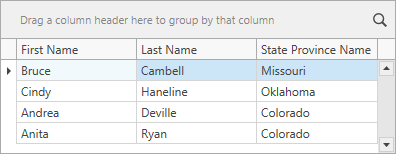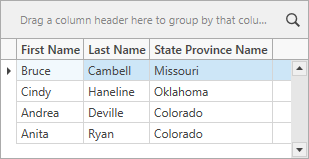How to: Bind the Grid to a Collection of Columns
- 5 minutes to read
This topic describes how to define columns in a View Model and display them in the GridControl.
Assign ViewModel Columns to the GridControl
This scenario demonstrates how to display information from an employee data model in the GridControl.

Create a class that describes a grid column:
Specify a collection of columns in the ViewModel:
public class ViewModel : ViewModelBase { public ViewModel() { // ... Columns = new ObservableCollection<Column>() { new Column(nameof(Employee.FirstName)), new Column(nameof(Employee.LastName)), new Column(nameof(Employee.StateProvinceName)) }; } // ... public ObservableCollection<Column> Columns { get; } }If you want the GridControl to reflect changes made in the Columns collection, this collection should implement the INotifyCollectionChanged interface.
The GridControl generates columns based on column templates. Add a default column template.
Use the DependencyObjectExtensions.DataContext attached property when you bind the GridControl to column properties. This attached property synchronizes data updates of bound properties to enhance grid performance:
<Window.Resources> <DataTemplate x:Key="DefaultColumnTemplate"> <dxg:GridColumn FieldName="{Binding Path=(dxci:DependencyObjectExtensions.DataContext).FieldName, RelativeSource={RelativeSource Self}}"/> </DataTemplate> </Window.Resources>Assign the column collection to the DataControlBase.ColumnsSource property. Set the DataControlBase.ColumnGeneratorTemplate property to a template that generates columns:
<dxg:GridControl ... ColumnsSource="{Binding Columns}" ColumnGeneratorTemplate="{StaticResource DefaultColumnTemplate}"/>
Add a Lookup Column
If you want to specify extra column types (for example, to display a list of states in a column’s combo box), follow the steps below:

Add an enumeration that lists column types:
Create a class that describes a lookup column:
public class Column : BindableBase { public Column(SettingsType settings, string fieldname) { Settings = settings; FieldName = fieldname; } public SettingsType Settings { get; } public string FieldName { get; } } public class LookupColumn : Column { public LookupColumn(SettingsType settings, string fieldname, IList source): base(settings, fieldname) { Source = source; } public IList Source { get; } }Add a lookup column to the ViewModel’s Columns collection and specify the lookup’s data source:
public class ViewModel : ViewModelBase { public ViewModel() { // ... States = Source.Select(x => x.StateProvinceName).Distinct().ToList(); Columns = new ObservableCollection<Column>() { new Column(SettingsType.Default, nameof(Employee.FirstName)), new Column(SettingsType.Default, nameof(Employee.LastName)), new LookupColumn(SettingsType.Lookup, nameof(Employee.StateProvinceName), States) }; } // ... public ObservableCollection<Column> Columns { get; } public List<string> States { get; } }Create a template that generates lookup columns:
<DataTemplate x:Key="LookupColumnTemplate"> <dxg:GridColumn FieldName="{Binding Path=(dxci:DependencyObjectExtensions.DataContext).FieldName, RelativeSource={RelativeSource Self}}"> <dxg:GridColumn.EditSettings> <dxe:ComboBoxEditSettings ItemsSource="{Binding Source}"/> </dxg:GridColumn.EditSettings> </dxg:GridColumn> </DataTemplate>
Add a Template Selector to Choose among Multiple Templates
Your application now contains the DefaultColumnTemplate and LookupColumnTemplate. To choose a template based on the column type, create a template selector and assign it to the DataControlBase.ColumnGeneratorTemplateSelector property:
using System.Windows;
using System.Windows.Controls;
namespace ColumnsSample {
public class ColumnTemplateSelector : DataTemplateSelector {
public DataTemplate DefaultColumnTemplate { get; set; }
public DataTemplate LookupColumnTemplate { get; set; }
public override DataTemplate SelectTemplate(object item, DependencyObject container) {
Column column = item as Column;
if(column == null) return null;
switch(column.Settings) {
case SettingsType.Default:
return DefaultColumnTemplate;
case SettingsType.Lookup:
return LookupColumnTemplate;
}
return null;
}
}
}
<Window.Resources>
<!-- ... -->
<local:ColumnTemplateSelector x:Key="ColumnTemplateSelector"
DefaultColumnTemplate ="{StaticResource DefaultColumnTemplate}"
LookupColumnTemplate ="{StaticResource LookupColumnTemplate}"/>
</Window.Resources>
<dxg:GridControl ItemsSource="{Binding Source}"
ColumnsSource="{Binding Columns}"
ColumnGeneratorTemplateSelector="{StaticResource ColumnTemplateSelector}"/>
Specify Column Settings
You can use the DataControlBase.ColumnGeneratorStyle property to create a style that specifies column settings. The GridControl applies these settings to all columns generated from templates:

<dxg:GridControl.ColumnGeneratorStyle>
<Style TargetType="dxg:GridColumn">
<Setter Property="FilterPopupMode" Value="CheckedList" />
<Setter Property="Width" Value="Auto" />
<Setter Property="ReadOnly" Value="True" />
<Setter Property="HorizontalHeaderContentAlignment" Value="Center" />
<Setter Property="HeaderStyle">
<Setter.Value>
<Style TargetType="dxg:BaseGridHeader">
<Setter Property="FontWeight" Value="SemiBold" />
</Style>
</Setter.Value>
</Setter>
</Style>
</dxg:GridControl.ColumnGeneratorStyle>
You can also use multiple data annotation attributes to define validation rules and format options:
public class Employee {
[ReadOnly(true)]
public string FirstName { get; set; }
[MinLength(3)]
public string LastName { get; set; }
public string StateProvinceName { get; set; }
}